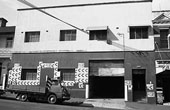THE BLACK THEATRE
© GUWANYI; Stories of the Redfern Aboriginal community.
An exhibition at the Museum of Sydney 21 December 1996 – 4 May 1997





Because of the efforts of a small but dedicated group of people who felt the need for such an enterprise there came into existence a black theatre in New South Wales. These people saw the theatre as being established for the following purpose:
· to provide a theatre which would be able to perform the many plays that were written by young Aboriginal writers
· to give cultural expression to both the urban and rural experience of life for Aboriginal people through a variety of mediums, and
· to provide professional training for Aboriginal people in all aspects of theatre and media.
The Black Theatre was formed in 1972 to supply people with art forms to which they could relate. It grew out of political struggle, especially the land rights demonstrations which at the time were being organised by the Black Moratorium Committee. Those who were not political celebrities found they could become involved as actors and dancers etc. and that they could show their convictions in this way. Many had not realised the political force that the theatre represented.
The first public performance by Black Theatre was street theatre in 1972 to publicise the Black Moratorium and the Aboriginal land rights claim against Nabalco. The next performance was to lead the Aboriginal land rights demonstration in July of that year where for the first time Aboriginal people with their families came out on the streets in large numbers to support their younger people. A few days after the land rights demonstration the news came through that the Aboriginal embassy in Canberra had collapsed. It was at the re-erection of the Aboriginal Tent Embassy that the Black Theatre held its first performance.
It performed the ‘dance of the embassy’ which was a symbolic re-erection of the tent embassy but portrayed the whole history of Aboriginal / European conflict and gave powerful expression to the emotions of that event.
The embassy was a crisis point of Aboriginal legal action in Australia. When this subsided some of the activists found a new arena – the stage. A warehouse was rented in Redfern and set up as the headquarters of the Black Theatre. It was a creative hub for artists and where the public congregated socially to see plays that were written by Aboriginal playwrights and produced by Aboriginal people.
In 1973-74, The Cakeman by Bob Merritt had received enormous attention from the Aboriginal and non-Aboriginal communities. Unfortunately Bob Merritt’s vision of seeing his play performed by the Black Theatre was denied as he was an inmate of Long Bay jail. Attempts were made to gain his release, however ministerial bureaucracy intervened. In 1975 the Theatre took on a new name and changed from National Black Theatre to Aboriginal Black Theatre Arts & Cultural Centre. In 1976 Here comes the nigger, by Gerry Bostock, also provoked attention. Bostock and Merritt acquired their dramatic talents from experience rather than formal education. Theatre gave urban and rural Aboriginal artists a platform and an opportunity to express their stories, attitudes, feelings and spirituality, about life and contemporary society.
The Theatre had funding problems, which escalated when the then Prime Minister Malcolm Fraser announced that cultural activities involving Aboriginal people would no longer be helped by the Department of Aboriginal Affairs, but would become the responsibility of the Australia Council. No funds were granted to the Council for its additional responsibilities.
The manager of the Black Theatre, Mr Lester Bostock recalled that the Theatre had applied to the Department and to the Australia Council for assistance but had received no reply. Lack of funding had become an enormous strain on the Theatre, and all involved. By the end of 1977 the Black Theatre had ceased operating. Lester Bostock reflected on the positive outcomes of the theatre. It had developed a state of mind and it was also a focus of energy, because it became part of the urban myth of Redfern, where the kooris and Murries knew their grass roots and knew their artistic endeavours. Many individuals have gone onto radio, television, dance or drama and now contemporary Aboriginal culture is recognised throughout the world.
TEXT COURTESY OF LESTER BOSTOCK
The booklet from this exhibition is available in some second-hand book stores.

Photos Unnamed- Bettie Fisher? Cope St warehouse, Bob Maza, Bindi Williams, Aileen Corpus, Gary Foley ,
Program cover for Here comes the nigger, 1976, courtesy Gerry and Lester Bostock - Powerhouse Museum exhibition, 2002